Abstract
Our previous studies have demonstrated the inadequate nutritional status of Vietnamese female marriage immigrants in Korea. Major possible reasons include food insecurity due to economic problems as well as a lack of adjustment to unfamiliar Korean foods and limited access to Vietnamese foods; however, no study has investigated food insecurity among such intermarried couples. This study was performed to investigate the prevalence of food insecurity in Korean-husband-Vietnamese-wife couples and to determine whether they exhibit an intrahousehold discrepancy regarding food insecurity. A cross-sectional analysis of the Cohort of Intermarried Women in Korea study was performed with 84 intermarried couples. Among the 84 Vietnamese immigrants, 48.8% and 41.7% had food insecurity due to economic problems and a lack of foods appealing to their appetite, respectively. There was a marked discrepancy in reporting food insecurity between Vietnamese wives (22.6-38.1%) and their Korean husbands (6.0-15.5%). Vietnamese wives were five and two times more food-insecure due to economic problems and no foods appealing to their appetite, respectively, than their Korean spouses. A follow-up study is needed to investigate the causes of this discrepancy and ways of reducing food insecurity among female marriage immigrants living in low-income, rural communities.
The number of female immigrants arriving in Korea through marriage has been increasing rapidly since 1990, especially more recently, with the number of marriages between Korean men and foreign women increasing by 362% between 2000 and 2009 (25,142 cases) [1]. Our previous studies have revealed the inadequate nutritional status of Vietnamese female marriage immigrants as well as their Korean spouses [2-4], who account for the second highest rate of intermarriage after Chinese women [1,5].
Food insecurity is defined as "limited or uncertain availability of nutritionally adequate and safe foods resulting from financial resource constraints" [6]. The World Food Summit of 1996 defined food security as existing "when all people at all times have access to sufficient, safe, nutritious food to maintain a healthy and active life" [7]. Therefore, both financial and access constraints should be considered when addressing food insecurity. In the USA, households with immigrants were more likely to have food insecurity than households in which all members were born in the USA [8-14]. Furthermore, the prevalence of food insecurity in the USA was higher among female immigrants (35%) than among economically underprivileged females (16%) [15]. In Korea, the rate of household food insecurity in rural areas (9.9%) is about two times higher than the national average (5.4%) [16,17]. Most Korean men who are married to Vietnamese women have a low socioeconomic status and live in rural communities [2-4]. Therefore, these intermarried couples and their heightened economic difficulties are far more susceptible to food insecurity than their nonintermarried counterparts. In addition, new immigrant wives have an impaired ability to gain access not only to nutritionally adequate foods but also to culturally acceptable foods, partly due to a lack of adjustment to unfamiliar Korean foods and limited access to Vietnamese foods. At the same time, Korean spouses may not have sufficient access to Korean foods because it is the Vietnamese wives-who are not familiar with Korean foods and cooking-who are mainly responsible for preparing meals in most of these families (72.2%) [2]. Therefore, both Korean husbands and their Vietnamese wives may experience food insecurity, not only due to economic problems but also due to the unavailability of foods that appeal to their appetite.
While food insecurity may be a major contributor to nutritional inadequacy among intermarried couples in Korea, no study has investigated food insecurity among such couples. Most previous studies of food insecurity among immigrants have involved children [13,15,18] and Hispanic [18], Latino [9,10,14,19], and Mexican [12,13] adults participating in food-assistance programs [19-21] in the USA, as well as adult immigrants from Colombia in Canada [20]. In addition, only one previous study has investigated the discordance of 13 food insecurity items between native Bangladeshi couples living in Bangladesh [22]. Therefore, the present study investigated the prevalence of food insecurity in Korean-husband-Vietnamese-wife couples in Korea to determine whether they exhibit an intrahousehold discrepancy regarding food insecurity. In addition, we compared general characteristics, daily nutrient and food intakes, and blood profiles between the subjects with and without food insecurity.
The participants were Vietnamese female marriage immigrants who voluntarily participated in the Cohort of Intermarried Women in Korea study, which is an ongoing, prospective, epidemiological study that forms part of the Korean Genome and Epidemiology Study (KoGES), established in November of 2006, as described elsewhere [2-4]. Those eligible for the study were female marriage immigrants from Vietnam, their Korean spouses (who had been in Korea for > 6 months), and their children, who were contacted regularly by local governmental health officials in centers that support families of intermarried couples. As a baseline investigation, subjects received either a telephone call or an advertisement inviting them to attend a comprehensive health screening at local clinical centers in Seoul, Busan, Daegu, Danyang, Gimhae, Gwangju, Gyeongju, Gongju, Jinju, Sangju, Masan, Okcheon, and Pohang, Korea, between May and August 2009. Among the 287 immigrant respondents, 96 subjects visited health clinics with their spouses. Of those 96 husbands, data for 12 were excluded because of insufficient information on anthropometry (n = 3), sociodemographic characteristics (n = 2), dietary intakes (n = 4), or food insecurity (n = 3). Therefore, 84 intermarried couples were finally eligible for this analysis. The anthropometric, sociodemographic characteristics, and food insecurity did not differ significantly between subjects with (n = 84) and without (n = 203) sufficient spouse data. The anthropometric parameters and sociodemographic characteristics did not differ significantly between subjects who were excluded and included in the analysis. The study protocol was approved by the Human Investigation Review Board of Ewha Womans University College of Medicine, and informed consent to participate was obtained from all subjects.
Food insecurity was measured using two questions regarding economic difficulty and two questions regarding lack of appetizing foods, through face-to-face interviews. The United States Department of Agriculture (USDA) household food insecurity measurements [6] and modified USDA household food insecurity questionnaires have been validated [16] to be applied to the Koreans, but have not been validated for Vietnamese immigrants in Korea. The following two questions from the six-item short-form of the United States Household Food insecurity Survey Module [6] were used to assess food insecurity due to economic problems: "Did you ever reduce the size of meals or ate less than you desired because there was not enough money for food in the last year?" (Q1), and "Did you ever skip meals because there was not enough money for food in the last year?" (Q2). In addition, we modified Q1 and Q2 to measure food insecurity due to lack of availability of foods that subjects desired to eat or because a lack of foods that appealed to their appetite: "Did you ever feel hungry because there were no foods that you wanted to eat or no foods that appealed to your appetite at home in the last year?" (Q3), and "Did you ever skip meals because there was no food that you wanted to eat or there was no food that appealed to your appetite at home in the last year?" (Q4). A food insecurity score was used to assess concordance with the degree of food insecurity between couples for each of the four questions. All items were weighted equally and scored 1 for yes and 0 for no, and each individual had scores that ranged from 0 to 1. The anthropometric parameters and sociodemographic characteristics (household income, education level, and length of residence) did not differ significantly between respondents (95%) and nonrespondents (5%) to the four food insecurity questions.
Each subject was individually interviewed by trained technicians and graduate students to obtain data regarding their sociodemographic characteristics, food consumption, and dietary behaviors, using standard protocols. Vietnamese translators fluent in both Korean and Vietnamese helped in the investigation process. Household monthly income was classified as < US$ 1,000, US$ 1,000-1,499, US$ 1,500-2,000, and > US$ 2,000. The education level of the Vietnamese wives and their Korean husbands was categorized as ≤ elementary school, middle school, and ≥ high school. Length of residence in Korea was classified as < 1, 1-3, 4-7, and > 7 years. Food consumption by intermarried couples was assessed using a 1-day 24-hour recall. Food models and photographs were used to explain the portion sizes. Dietary intake data were analyzed using the Computer Aided Nutritional Analysis program version 3.0 software (CAN-Pro 3.0).
Standing height and body weight were measured using an automatic height/weight-measuring instrument (Dong Sahn Jenix, Seoul, Korea) by trained nurses or medical doctors. Body mass index was calculated, and waist and hip circumferences were measured with a tape measure (Anthropometric tape, Preston 5193, Seoul, Korea). Blood pressure was measured using an automatic blood pressure calculator FT0500R (Jawon Medical, Gyeongsan, Korea) after a 10-minute rest in the sitting position; the average of two measurements was used. Blood samples were drawn after an 8-hour overnight fast into EDTA tubes. The plasma samples were centrifuged at 3,500 rpm for 10 minutes at 4℃ and stored at -70℃ until analysis. Fasting plasma levels of glucose, total cholesterol, triglyceride (TG), albumin, hemoglobin, hematocrit, and high-density lipoprotein (HDL)-cholesterol were measured with an autoanalyzer (ADVIA 1550, Bayer Diagnostics, Tarrytown, NY, USA); low-density lipoprotein (LDL)-cholesterol was calculated as total cholesterol-HDL-cholesterol-(TG/5) [23].
All analyses were performed using SPSS software (version 12.0) and the data are expressed as mean ± SD values (continuous variables) or as numbers and percentages (categorical variables). Student's t-test was used to compare anthropometric parameters and blood biochemical profiles between subjects with and without food insecurity. The Pearson's χ2 test or fisher's exact test was used to assess whether intermarried couples reported food insecurity differently. The level of statistical significance was defined as P < 0.05.
The Korean husbands were aged 41.0 ± 5.6 years and 41.7% of them were over 50 years, and there was a large age gap within intermarried couples (mean = 16.5 years; Table 1). About half of the Korean husbands had an education level below middle school (57.1%), and had a low income level (< US$ 1,500, 48.8%; Table 1). Most of the Vietnamese immigrants (89.3%) did not meet the estimated energy requirement (EER), and the proportion of immigrants whose nutrient intakes did not meet the estimated average requirement (EAR) [24] was > 50% for most nutrients (calcium, iron, vitamin B2, vitamin C, and folate; data not shown). Only 10.7% of the Korean husbands met the EER, and the proportion of Korean husbands below the EAR for Koreans [24] was highest for folate (84.5%) and lowest for phosphorus (8.3%) and iron (8.3%; data not shown).
Vietnamese wives with food insecurity due to economic problems had significantly lower intake levels of fiber (P = 0.046), vitamin C (P = 0.047), and folate (P = 0.038) (Appendix table). Korean husbands, whose wives reduced their meal sizes or ate less than they desired due to economic problems had significantly higher LDL-cholesterol levels (P = 0.030) and lower TG levels (P = 0.017), mean corpuscular hemoglobin (P = 0.046), and fruit intake (P = 0.028; appendix table). Korean husbands, whose wives skipped the meals due to lack of foods that appealed to their appetite during the last year had lower intakes of calcium/1,000kcal (P = 0.004) and vitamin C/1,000kcal (P = 0.049; appendix table).
There was a marked discrepancy in the reporting of food insecurity between Vietnamese wives (22.6-38.1%) and their Korean husbands (6.0-15.5%; Table 1). Five and two times as many Vietnamese wives indicated food insecurity due to economic problems and lack of foods appealing to their appetite, respectively, than their Korean spouses (Table 2). The discordance within intermarried couples ranged from 21.4% for Q1 to 39.3% for Q3. The reported difference was greater for food insecurity due to economic problems (40.5%) than for food insecurity due to a lack of foods that appealed to the subject's appetite (25%) (Table 2).
Questions about food insecurity were added to an existing questionnaire from 2009, since data from previous studies suggest that food insecurity is related to poor health and the nutritional status of intermarried couples [2-4]. We found that Vietnamese female marriage immigrants in Korea had a high prevalence of food insecurity, with approximately 50% of them experiencing food insecurity due to economic difficulties and 46% due to a lack of foods that appealed to their appetite. This prevalence of food insecurity was greater than that found among the low-income elderly (22.7%) [25], but similar to that of recipients of the National Basic Livelihood Security System (42.1%) [26], which supports households with incomes below the minimum cost of living in Korea. The average age of the Korean husbands was 41.0 years, and about 40% of them were over 50 years. Thus, financial hardship in these households is unlikely to improve in the future, since the heads of these households will be retiring within 10-20 years.
This high prevalence of food insecurity may be due not only to the low socioeconomic status of the subjects but also to the limited programs available supporting household food security for low-income families. Although 79% of our subjects had a monthly household income of ≤ US$ 2,000, most of them may not be beneficiaries of the National Basic Livelihood Security System due to its limited income eligibility (US$ 504 per household with one person, US$ 858 with two, US$ 1,110 with three, and US$ 1,363 with four) [27] and low coverage (reported to be 40% of eligible multicultural families in Chungnam province) [28]. The Nutri Plus program (Korean supplemental nutrition program for women, infants, and children) also has strict eligibility criteria (infants and pregnant or nursing mothers with at least one nutrition risk factor such as anemia, being underweight, undergrowth, or nutritional inadequacy, and with income below 200% of the minimum cost of living) [29] and voluntary participation. Limited availability to various foods, especially Vietnamese foods, in rural communities and/or adaptation to new Korean foods may be another contributor towards food insecurity amongst this immigrant group.
We found a marked discrepancy regarding food insecurity between Vietnamese wives and their Korean husbands. This discordance was higher (30.4%) than that reported in Bangladesh (15%) [22], and about 40% of couples reported their food insecurity level differently, which is higher than native Bangladeshi husbands and wives living in Bangladesh found previously [22]. Our relatively high discordance can be partly explained by the intermarriage status of our subjects and the wives' relatively short duration of stay in Korea. Traditional Korean culture could be another significant contributor to the high discrepancy. Chemyon, as one's social image, is related to certain psychological concepts such as self-esteem, influencing the formation or maintenance of social relationships in East Asian countries that follow Confucianism [30]. In Korea, males are more likely to be involved in activities to fulfill their image-related social expectations, such as Chemyon, than in emotion [31]. Korean spouses might feel too humiliated or disgraced to answer, "I am food insecure due to economic problems". In the present study, Vietnamese wives reported more food insecurity than their Korean husbands. It is therefore possible that the food insecurity of Korean husbands was underreported herein due to social stigma, without potential benefits such as food support programs for low-income multicultural families in Korea. Several previous studies [32-34] have found that the level of food insecurity was much higher for food-support program participants than nonparticipants who were eligible for the program.
While previous studies have found food insecurity to be negatively associated with diet quality and disturbed eating patterns [35-40], no differences existed in sociodemographic characteristics and nutrient and food intakes between subjects with and without food insecurity in the present study. This could be due to the subjects' insufficiently low nutrient intakes [2-4], regardless of food insecurity. Although it has been reported that food insecurity is associated with chronic diseases such as hypertension, hyperlipidemia, and diabetes among low-income participants [41], our blood biochemical profiles did not differ significantly between Vietnamese wives with and without food insecurity, and most of the average values were within the normal range because most of our female subjects were in their 20s. On the other hand, husbands whose wives had reported food insecurity due to economic problems (Q1 or Q2) had significantly lower systolic blood pressure (P = 0.045), mean corpuscular volume (P = 0.029), and mean corpuscular hemoglobin (P = 0.026), while husbands whose wives were food insecure due to a lack of foods that appealed to their appetite (Q3 or Q4) had a lower diastolic blood pressure (P = 0.003; appendix table). We were unable to analyze differences in nutrient intake and blood profiles between Korean husbands with and without food insecurity because the prevalence of food insecurity among the husbands was too small to yield statistically significant differences. Some studies have found that the nutrient intakes of children in households with food insecurity were inadequate [12,13,15, 18,42]. Therefore, a follow-up study is needed to determine the nutrition status of children in multicultural families.
There were several limitations in the present study. First, the USDA household food insecurity measurements [6] and modified USDA household food insecurity questionnaires have been validated [16] and tested [16,17,26] for use with Koreans, but have not been validated for Vietnamese immigrants in Korea. Second, the present study was a baseline, preliminary investigation and evaluation of food insecurity and its relationship to poor health and nutritional status in intermarried couples living in low-income, rural communities, a follow-up study is needed to develop a methodologically valid and reliable food insecurity module for these intermarried couples. Third, a 1-day 24-hour recall may not be sufficient to assess normal daily intake due to the large intraindividual variability in food and nutrient intake. However, our study involved trained dietitians using standard protocols to help the subjects reflect on their daily diet to minimize bias, if it existed. Finally, although Vietnamese translators fluent in both Korean and Vietnamese assisted whenever needed, there were still some communication problems, especially with female immigrants who had lived in Korea for a relatively short time and/or had a low level of education.
On the other hand, this was the first study to analyze differences in indications of food insecurity between wives and husbands in Korea, as well as within intermarried couples. Therefore, the results of the present study may be helpful to policy makers and dietitians in the development and implementation of nutrition and health programs for multicultural families living in Korea. A follow-up study is needed to investigate why a food-insecurity discrepancy exists among female marriage immigrants and their Korean husbands living in low-income, rural communities.
Figures and Tables
Appendix
Appendix
Table A. Daily food intakes of Vietnamese female immigrants according to each four question of food insecurity†,‡,§
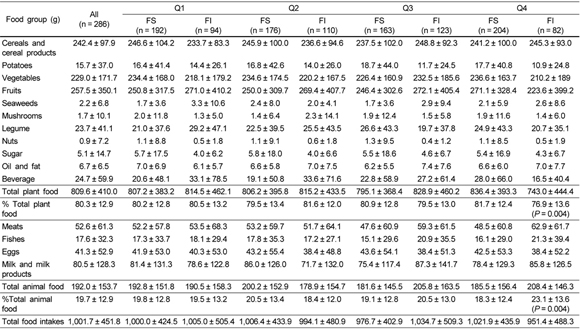
†Values are mean ± SD.
‡Student's t-test for differences between food insecurity group and food security group.
§FS = Food secure, FI = Food insecure
Table B. Daily nutrient intakes of Vietnamese female immigrants according to each four question of food insecurity†,‡,§
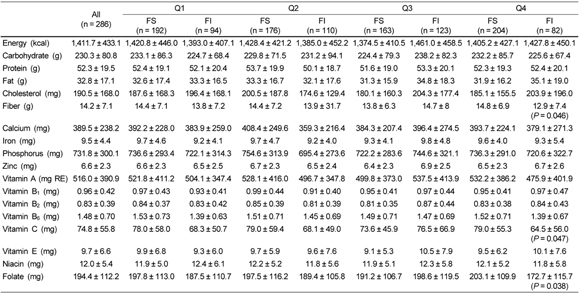
†Values are mean ± SD.
‡Student's t-test for differences between food insecurity group and food security group.
§FS = Food secure, FI = Food insecure
Table C. Daily nutrient intakes (per 1,000 kcal) of Vietnamese female immigrants according to each four question of food insecurity†,‡,§
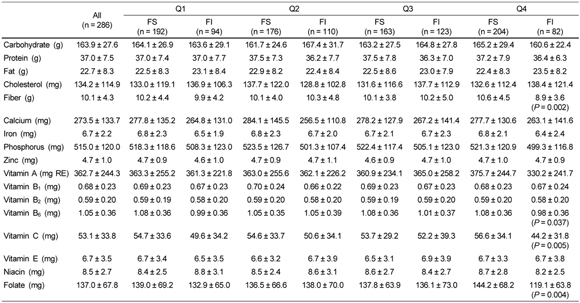
†Values are mean ± SD.
‡Student's t-test for differences between food insecurity group and food security group.
§FS = Food secure, FI = Food insecure
Table D. Blood profiles and blood pressure of Vietnamese female immigrants according to each four question of food insecurity†,‡,§
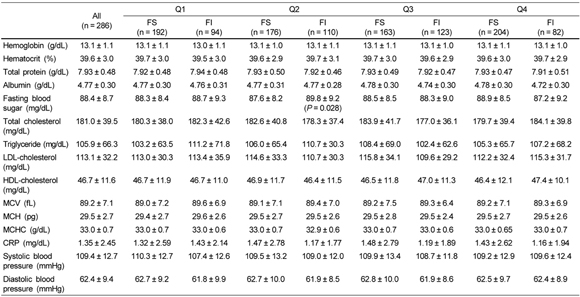
†Values are mean ± SD.
‡Student's t-test for differences between food insecurity group and food security group.
§FS = Food secure, FI = Food insecure
Table E. Daily food intakes of Korean husbands according to each four question of food insecurity of their Vietnamese wives†,‡,§

†Values are mean ± SD.
‡Student's t-test for differences between food insecurity group and food security group.
§FS = Food secure, FI = Food insecure
Table F. Daily nutrient intakes of Korean husbands according to each four question of food insecurity of their Vietnamese wives†,‡,§
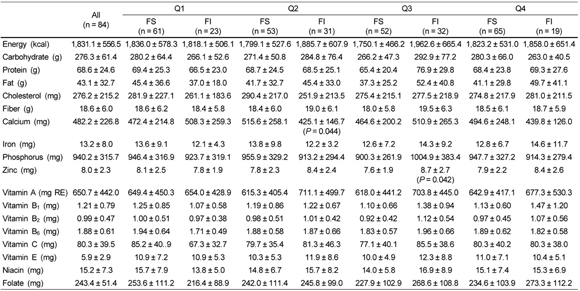
†Values are mean ± SD.
‡Student's t-test for differences between food insecurity group and food security group.
§FS = Food secure, FI = Food insecure
References
1. Population and households of Koreans. Korea National Statistical Office [Internet]. accessed 2009. Available from: http://kostat.go.kr.
2. Kim SH, Kim WY, Lyu JE, Chung HW, Hwang JY. Dietary intakes and eating behaviors of Vietnamese female immigrants to Korea through marriage and Korean spouses and correlations of their diets. Korean J Community Nutr. 2009. 14:22–30.
3. Hwang JY, Lee SE, Kim SH, Chung HW, Kim WY. Psychological distress is associated with inadequate dietary intake in Vietnamese marriage immigrant women in Korea. J Am Diet Assoc. 2010. 110:779–785.

4. Lyu JE, Yang YJ, Lee SE, Chung HW, Kim MK, Kim WY. Nutritional status of Vietnamese female marriage immigrants to Korea in relation to length of residence in Korea. Ann Nutr Metab. 2009. 55:317–324.

5. Ministry of Justice of Republic of Korea. Immigration Service Statistics 2009. Seoul, Korea: IT Planning & Statistics Team of Ministry of Justice.
6. Bickel G, Nord M, Price C, Hamilton W, Cook J. Guide to Measuring Household Food Security, Revised 2000. 2000. Alexandria, VA: U.S. Department of Agriculture, Food and Nutrition Service.
7. The World Food Summit. In : Food and Agriculture Organization (FAO) Headquarters; 1996 Nov 13-17; Rome, Italy.
8. Kasper J, Gupta SK, Tran P, Cook JT, Meyers AF. Hunger in legal immigrants in California, Texas, and Illinois. Am J Public Health. 2000. 90:1629–1633.

9. Quandt SA, Shoaf JI, Tapia J, Hernández-Pelletier M, Clark HM, Arcury TA. Experiences of Latino immigrant families in North Carolina help explain elevated levels of food insecurity and hunger. J Nutr. 2006. 136:2638–2644.

10. Quandt SA, Arcury TA, Early J, Tapia J, Davis JD. Household food security among migrant and seasonal Latino farmworkers in North Carolina. Public Health Rep. 2004. 119:568–576.

11. Borjas GJ. Immigration and the Food Stamp Program. 1999. Cambridge, MA: Harvard University Press.
12. Kaiser LL, Melgar-Quiñonez HR, Lamp CL, Johns MC, Sutherlin JM, Harwood JO. Food security and nutritional outcomes of preschool-age Mexican-American children. J Am Diet Assoc. 2002. 102:924–929.

13. Kersey M, Geppert J, Cutts DB. Hunger in young children of Mexican immigrant families. Public Health Nutr. 2007. 10:390–395.

14. Kaiser LL, Townsend MS, Melgar-Quiñonez HR, Fujii ML, Crawford PB. Choice of instrument influences relations between food insecurity and obesity in Latino women. Am J Clin Nutr. 2004. 80:1372–1378.

15. Chilton M, Black MM, Berkowitz C, Casey PH, Cook J, Cutts D, Jacobs RR, Heeren T, de Cuba SE, Coleman S, Meyers A, Frank DA. Food insecurity and risk of poor health among US-born children of immigrants. Am J Public Health. 2009. 99:556–562.

16. Kim K, Kim MK. Development and validation of food security measure. Korean J Nutr. 2009. 42:374–385.

17. Kim K, Kim MK, Shin YJ. Household food insecurity and its characteristics in Korea. Health Soc Welf Rev. 2009. 29:268–292.

18. Dave JM, Evans AE, Saunders RP, Watkins KW, Pfeiffer KA. Associations among food insecurity, acculturation, demographic factors, and fruit and vegetable intake at home in Hispanic children. J Am Diet Assoc. 2009. 109:697–701.

19. Kuyper EM, Espinosa-Hall G, Lamp CL, Martin AC, Metz DL, Smith D, Townsend MS, Kaiser LL. Development of a tool to assess past food insecurity of immigrant Latino mothers. J Nutr Educ Behav. 2006. 38:378–382.

20. Rush TJ, Ng V, Irwin JD, Stitt LW, He M. Food insecurity and dietary intake of immigrant food bank users. Can J Diet Pract Res. 2007. 68:73–78.

21. Nam Y, Jung HJ. Welfare reform and older immigrants: food stamp program participation and food insecurity. Gerontologist. 2008. 48:42–50.

22. Coates JC, Webb P, Houser RF, Rogers BL, Wilde P. "He said, she said": who should speak for households about experiences of food insecurity in Bangladesh? Food Sec. 2010. 2:81–95.

23. Friedewald WT, Levy RI, Fredrickson DS. Estimation of the concentration of low-density lipoprotein cholesterol in plasma, without use of the preparative ultracentrifuge. Clin Chem. 1972. 18:499–502.

24. Dietary Reference Intakes for Koreans. 2005. Korea: The Korean Nutrition Society.
25. Kwon SO, Oh SY. Associations of household food insecurity with socioeconomic measures, health status and nutrient intake in low income elderly. Korean J Nutr. 2007. 40:762–768.
26. Oh SY, Kim MY, Hong MJ, Chung HR. Food security and children's nutritional status of the households supported by the national basic livelihood security system. Korean J Nutr. 2002. 35:650–657.
27. Report of the National Minimum Living Security System. 2008. Korea: Ministry of Health & Welfare.
28. Female marriage immigrant and households of Koreans. Korea National Statistical Office [Internet]. accessed 2009. Available from: http://kostat.go.kr.
29. Guidelines of the Nutri Plus Program. 2010. Korea: Ministry of Health & Welfare.
30. Choi SC, Lee SJ. Two-component model of Chemyon-oriented behaviors in Korea constructive and defensive Chemyon. J Cross Cult Psychol. 2002. 33:332–345.
31. Hahn DW, Kim KM. The gender consensus and differences in understanding of Korean culture and common social values. Korean J Woman Psychol. 2004. 9:23–42.
32. Wilde PE. Measuring the effect of food stamps on food insecurity and hunger: research and policy considerations. J Nutr. 2007. 137:307–310.

33. Gundersen C, Oliveira V. The food stamp program and food insufficiency. Am J Agric Econ. 2001. 83:875–887.

34. Gibson-Davis CM, Foster EM. A cautionary tale: using propensity scores to estimate the effect of food stamps on food insecurity. Soc Serv Rev. 2006. 80:93–126.

35. Kendall A, Olson CM, Frongillo EA Jr. Relationship of hunger and food insecurity to food availability and consumption. J Am Diet Assoc. 1996. 96:1019–1024.

36. Vailas LI, Nitzke SA, Becker M, Gast J. Risk indicators for malnutrition are associated inversely with quality of life for participants in meal programs for older adults. J Am Diet Assoc. 1998. 98:548–553.

37. Hamelin AM, Habicht JP, Beaudry M. Food insecurity: consequences for the household and broader social implications. J Nutr. 1999. 129:525S–528S.

38. Klesges LM, Pahor M, Shorr RI, Wan JY, Williamson JD, Guralnik JM. Financial difficulty in acquiring food among elderly disabled women: results from the Women's Health and Aging Study. Am J Public Health. 2001. 91:68–75.

39. Tarasuk VS. Household food insecurity with hunger is associated with women's food intakes, health and household circumstances. J Nutr. 2001. 131:2670–2676.

40. Champagne CM, Casey PH, Connell CL, Stuff JE, Gossett JM, Harsha DW, McCabe-Sellers B, Robbins JM, Simpson PM, Weber JL, Bogle ML. Lower Mississippi Delta Nutrition Intervention Research Initiative. Poverty and food intake in rural America: diet quality is lower in food insecure adults in the Mississippi Delta. J Am Diet Assoc. 2007. 107:1886–1894.





 PDF
PDF ePub
ePub Citation
Citation Print
Print


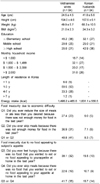

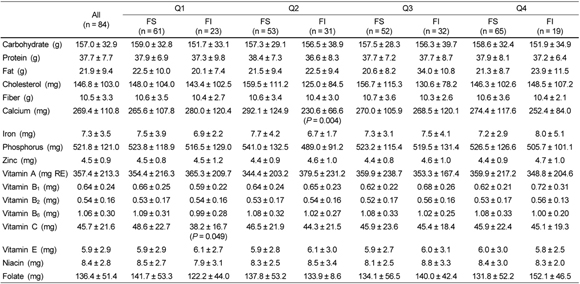
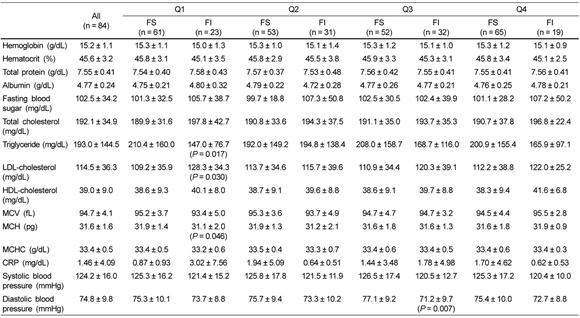
 XML Download
XML Download